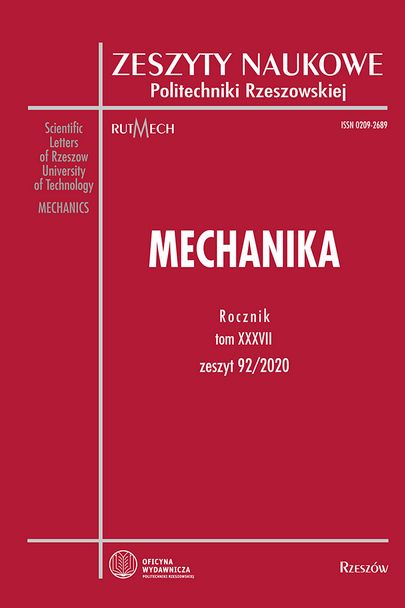Abstract
The toothed wheels of aircraft gears are characterized by a high reliability factor, required due to the area of application, dynamic nature of work and transmitted power. During the entire life cycle, the tooth flanks and the areas of their bases are exposed to damage due to various stress states occurring during the meshing and the period when the individual teeth of the mating gears are not in contact with each other. The concentration of these stresses, related to e.g. with the accuracy of the teeth, may lead to various types of defects, such as: "pitting", crushing, scrap, interference damage, abrasions, tears, chipping, seizure or overheating. Therefore, the gears are subject to, inter alia, residual stress tests using the X-ray diffraction method, for which the measurement procedure and preparation of the test material is problematic due to limited or impossible direct access to the required measurement areas. This article describes two methods of sample preparation for residual stress tests with the use of an X-ray diffractometer equipped with a chromium lamp. The scope of the research included: electrolytic polishing and electroerosive cutting. Prepared samples of gears representing the considered methods were subjected to a series of measurements on the test stand, and the obtained stress values, representing their states in the surface layer, were analyzed. The impact of both methods of gear preparation on the value of residual stresses in the top layer of gear teeth was compared and it was shown that the type of treatment used during sample preparation has an impact on the values of residual stresses.
References
Folęga P., Figlus T., Wyznaczanie naprężeń w podstawach zębów kół napędów zębatych, Politechnika Śląska, Gliwice, Journal of Machine Construction and Maintenance. Problemy Eksploatacji (4-2007), s. 83.
Kuhn F., Lopenhaus C., Klocke F., Model for the calculation of kinematic roughness in the tooth root, 12th CIRP Conference on Intelligent Computation in Manufacturing Engineering (18-20 July 2018).
Freborg A., Ferguson B., Li Z., Modeling Heat Treatment for Characterizing Distortion, Residual Stress, Loading Response and Fracture in a Vacuum Carburized and Gas Quenched Steel Coupon, DANTE Inc., Cleveland, Ohio USA,Thermal Process Modeling, Proceedings from the 5th International Conference on Thermal Process Modeling and Computer Simulation (16-18 June 2014), Gaylord Palms Resort & Convention Center, Orlando, FL, USA, editors: B.L. Ferguson, R. Goldstein and R. Papp.
www.carpentertechnology.com/en/product-solutions/cartech-pyrowear-53-alloy/ (dostęp: 01.04.2020).
Kacalak W., Szafraniec F., Charakterystyka topografii stref kontaktu w połączeniach stykowych powierzchni kształtowanych w procesie szlifowania, Mechanik, R. 90, nr 10 (2017), s. 921-923.
Jolivet S., Mezghani S., El Mansori M., Vargiolu R., Zahouani H., Experimental study of the contribution of gear tooth finishing processes to friction noise, Tribology International Vol. 115 (2017), s. 70-77.
Skrzypek S., Nowe metody pomiaru makronaprężeń własnych materiałów przy zastosowaniu dyfrakcji promieniowania X w geometrii stałego kąta padania, Wydawnictwo AGH, Kraków 2002.
Krajewska-Śpiewak J., Gawlik J., Wyznaczanie naprężeń własnych za pomocą metody rentgenograficznej w materiałach trudnoskrawalnych, Innowacje w Zarządzaniu i Inżynierii Produkcji, t. 1, red. R. Knosala, Oficyna Wydawnicza Polskiego Towarzystwa Zarządzania Produkcją (2017), s. 783-794.
Kocurek P., Nawrocki J., Kubiak K., Sieniawski J., Analiza stanu naprężeń własnych w odlewach segmentu aparatu kierującego turbiny silników lotniczych, Inżynieria Materiałowa, R. 36, nr 3 (2015), s. 129-133.
Krupa K., Habrat W., Kocurek P., Sieniawski J., Naprężenia własne w warstwie wierzchniej po toczeniu wykończeniowym stopu tytanu na osnowie fazy międzymetalicznej TiAl(γ), Mechanik, R. 86, nr 10 (2016), s. 1508-1509.
Gancarczyk K., Kocurek P., Analiza stanu naprężeń własnych i zawartości austenitu szczątkowego w kołach zębatych przekładni lotniczych, Prace XLII Szkoły Inżynierii Materiałowej, Wydawnictwo naukowe AKAPIT, Kraków 2014, s. 172-175.
Noyan I.C., Cohen J.B., Residual Stress Measurement by Diffraction and Interpretation, New York: Springer-Verlag 1987.
https://wp.kntu.ac.ir/asgari/ (dostęp: 31.06.2020).
Fillit R.Y., Perry A.J., Strandberg C., X-ray elastic constants, stress profiling and composition of physically vapor deposited ZrN films, Thin Solid Films, Vol. 197, Iss. 1-2, 10 March 1991, s. 47-55.
Fréour S., Lacoste E., François M., Guillén R., Determining Ti-17 β-Phase Single- Crystal Elasticity Constants through X-Ray Diffraction and Inverse Scale Transition Model, Materials Science Forum (Vol. 681), March 2011, s. 97-102.
Mittemeijer E.J., Scardi P., Diffraction Analysis of the Microstructure of Materials, Springer-Verlag Berlin Heidelberg (2004), s. 83.


